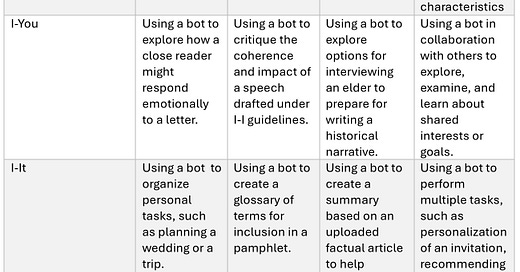This post depends upon a discussion of the personal pronoun system I posted recently. If you haven’t read it, you can probably make sense of this post, but I think a full understanding might depend on the previous idea. Also, if you decide to use this material with students or with teachers, I’d love to hear from you. If you decide to include it in your own publication, please cite this newsletter. Here’s the link to the earlier post if you’re interested:
AI, Writing, and Third Person Decisions
“Good morning, students,” Mr. Ruff said as the bustle of backpacks and chats subsided. “Good morning, Cecilia.”
Bot Use Decision Guide
This post provides a matrix to help high school and college student users decide when and how to use bots for different purposes and situations. Bots are software agents that can perform tasks, interact with users, or simulate human behavior, but they aren’t human. Human beings are ends in themselves, as Kant taught us. The matrix is based on the following dimensions:
The purpose of the human user: Personal, Public, Academic, or Hybrid
Personal—Using a bot for personal or private goals, such as entertainment, productivity, or self-improvement.
Public—Using a bot for public or social goals, such as information, advocacy, or community building.
Academic—Using a bot to scaffold educational work, such as reading, writing, problem-solving, studying, etc.
Hybrid—Using a bot for multiple or overlapping purposes, such as personal and public, or academic and hybrid.
The type of interaction: I-I, I-You, I-It, or It-It.
I-I interactions are self-referential or self-reflective; the important stuff is what goes in an individual mind; using a bot is counterproductive. Uses for productivity or entertainment are strictly low-level information.
I-You interactions are interpersonal and relational; overuse of a bot risks distortion of the human voice and increases the possibility of devolving to It-It status, that is, one human being reading the writing of a machine (the missing author syndrome). Requires considerable experience and instruction to become an effective bot user in this relationship.
I-It interactions are instrumental or functional; an IT can automate tasks (e.g., writing boilerplate, providing standardized information, summaries of products). Bot output serves as a proxy for the author and must be labeled as such.
It-It interactions are related to I-It interactions, but the author is completely unnecessary; inputting output into another bot or digital tool for exploration, experimentation, analysis, critique, etc., can be useful. Bot output must be labeled as combined output.
***
The matrix below shows some examples of bots for each combination of purpose and interaction. The examples are not exhaustive, but illustrative of the diversity and complexity of bot use. These examples are provisional and perhaps overly simplified, arising from my imagination. Please modify the language and adjust this matrix to fit your needs if this matrix is helpful to you.
Discussion Scenario: STEM
Lena, a high school student who loves biology and wants to pursue a career in biotechnology, is enrolled in an advanced biology course that requires her to conduct an independent research project on a topic of her choice. She decides to investigate the effects of different types of pesticides on the growth and development of plants. She needs to design and execute an experiment, collect and analyze data, and write a report summarizing her findings and conclusions.
She has access to a bot that can help her with various aspects of her project, such as finding relevant literature, setting up the experimental protocol, performing statistical tests, and generating graphs and tables. Lena doesn’t think she should use the bot to set up the experiment. Something tells her this part of the project is I-I. She’s not confident about it and thinks she might miss an opportunity to learn if she takes the easy way out. She believes it wouldn’t hurt to use the bot to help with finding literature, and it might help. Reading the actual literature will be I-You. She needs 100% pure human voices. She’s already comfortable with doing statistical tests and is curious to learn what the bot can do. She needs to learn to generate graphs and tables; the bot might be of some use here in the I-It relationship.
The bot is also able to answer some of her questions and provide feedback on her work. However, Lena is not sure whether and when she should use the bot. On one hand, she thinks that the bot could save her a lot of time and effort, and help her produce a high-quality report. On the other hand, she worries that the bot might take away some of the challenge and creativity of the project, and that she might not learn as much from the process. She would like to hear what her peers plan to do.
The work product that Lena must hand in is a written report that includes the following sections:
Introduction: This section should provide the background and context of the research topic, state the research question and hypothesis, and explain the significance and purpose of the study.
Methods: This section should describe the materials and procedures used in the experiment, including the variables, measurements, and controls.
Results: This section should present the data collected from the experiment, using graphs, tables, and descriptive statistics.
Discussion: This section should interpret and explain the results, compare them with existing literature, and discuss the implications and limitations of the study.
Conclusion: This section should summarize the main findings and conclusions of the study, and suggest directions for future research.
References: This section should list the sources cited in the report, using a consistent citation style. Use of the bot should be revealed in this section.
Discussion Scenario: History
Armando has two weeks to complete the following writing project which he selected from three options. The idea of writing about how people felt about living as a slave during the Civil War era is interesting to him because he sees a connection to migrant workers in California today. His history teacher is traditional when it comes to writing assignments. Instead of giving him information about the writing situation—the occasion for the writing, a potential audience, and nuances of the subject, the assignment simply states what the final product should look like.
Introduction: This section should introduce the topic of the essay and provide some background information on the historical context of slavery and the Civil War in the United States. It should also state the main thesis or argument of the essay, which should answer the question: What was it like to be a slave during the Civil War?
Armando knows that this assignment is an invitation to plagiarism in an I-It relationship. Many peers would copy this language into a bot. Within seconds they would have an introductory paragraph to work from. Understanding that he ought to be able to explain the context of slavery and the Civil War himself in his own words, an I-You relation, he decides not to copy and paste. He took to heart his teacher’s reminder that it’s dumb to use AI to make you dumber.
Body: This section should consist of several paragraphs, each focusing on a different aspect of the slave experience during the Civil War. Some possible aspects are:
The daily life and working conditions of slaves on plantations, farms, or in cities
The impact of the war on the slave population, such as violence, displacement, starvation, disease, or death
The opportunities and challenges of escaping to the North or joining the Union army as contrabands or soldiers
The role of slave resistance and rebellion in the war, such as the Underground Railroad, raids, or uprisings
The effect of emancipation and the end of the war on the slave community, such as freedom, citizenship, education, or discrimination
Each paragraph should have a clear topic sentence, supporting evidence from primary and secondary sources, and analysis of how the evidence supports the thesis. The paragraphs should be organized in a logical and coherent way, using transitions and connectors to show the relationships between ideas.
Armando found these directions amusing. In case any student had no idea what to write about, there it was, exactly what the teacher wanted writers to talk about. Why would a teacher worry that a kid might go to a bot for ideas when the teacher acts like a bot in giving the assignment.
Armando has seen many assignments like this one. In a way, he wishes his teacher had not told him what the body of the essay should be about. His uneasiness about the invitation to plagiarism gets a little more intense. He knows he could have this essay finished in a matter of 20 minutes. He knows he could tweak it so it would sound more human. It’s tempting partly because he knows his teacher is naïve about AI. He thinks about what he learned about motivation to learn vs. working for a grade from his English teacher, Mr. Ruff. He wanted to try learning and see what happens.
Conclusion: This section should summarize the main points and findings of the essay and restate the thesis using different words to indicate your fully understand your thesis. It should also explain the significance and implications of the essay, and answer the question: Why is it important to study and understand the experience of being a slave during the Civil War? It should also provide some suggestions for further research or inquiry on the topic.
Armando begins to wonder whether his history teacher used a bot to generate this assignment. If so, the assignment itself is I-It. The teacher gave an assignment written by IT for YOU. If the teacher is ok about using a text written in an I-It relation, why shouldn’t a student respond with an I-It essay? He felt himself inching toward his laptop, thinking about opening up a bot. Something held him back. Something told him that this decision would be important, not just because he wouldn’t learn a thing if he gave the task to IT, but because he would have to admit to himself that all he cares about is a grade. What about those slaves? What about those migrant workers?





I’m only beginning
You are making some serious headway. I like the Buber framework. I wonder though about how it will translate to others.